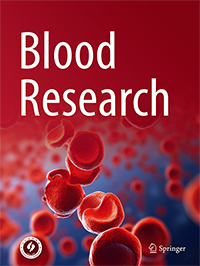Original Article
 Split Viewer
Split Viewer
Blood Res 2014; 49(2):
Published online June 25, 2014
https://doi.org/10.5045/br.2014.49.2.120
© The Korean Society of Hematology
White blood cell differential counts in severely leukopenic samples: a comparative analysis of different solutions available in modern laboratory hematology
1Department of Laboratory Medicine, The Catholic University of Korea, Seoul, Korea.
2Department of Pediatrics, The Catholic University of Korea, Seoul, Korea.
Correspondence to : Correspondence to Kyungja Han, M.D., Ph.D. Department of Laboratory Medicine, The Catholic University of Korea, 222, Banpo-daero, Seocho-gu, Seoul 137-701, Korea. Tel: +82-2-2258-1644, Fax: +82-2-2258-1719, hankja@catholic.ac.kr
This is an Open Access article distributed under the terms of the Creative Commons Attribution Non-Commercial License (http://creativecommons.org/licenses/by-nc/3.0/) which permits unrestricted non-commercial use, distribution, and reproduction in any medium, provided the original work is properly cited.
Background
We evaluated the efficacy of white blood cell (WBC) differential counts in severely leukopenic samples by the Hematoflow method and by automated hematology analyzers and compared the results with manual counts.
Methods
EDTA-anticoagulated blood samples (175 samples) with WBC counts of 40-990/µL were selected. Hematoflow differential counts were performed in duplicates employing flow cytometry using the CytoDiff reagent and analysis software. Differential counts were also performed using the DxH 800 (Beckman Coulter) and XE-2100 (Sysmex) automated hematology analyzers. The sum of the manual counts by a hematology technician and a resident were used as the manual counts.
Results
The total analysis time and hands-on time required by the Hematoflow method were shorter than those required by manual counting. Hematoflow counts were reproducible, showed a good correlation with automated analyzers, and also showed strong correlation with manual counts (r > 0.8) in neutrophils, lymphocytes, and monocytes. None of the cases containing less than 4% blasts as analyzed by the Hematoflow method had blasts in the manual counts, but 8 cases of 21 cases (38.1%) with over 4% blasts by Hematoflow had blasts in manual counts.
Conclusion
Hematoflow counts of severely leukopenic samples were reproducible and showed a good correlation with manual counts in terms of neutrophil, lymphocyte, and monocyte counts. The Hematoflow method also detected the presence of blasts. Manual slide review is recommended when over 4% blasts are found by Hematoflow.
Keywords Flow cytometry, Leukopenia, Differential leukocyte count
Article
Original Article
Blood Res 2014; 49(2): 120-126
Published online June 25, 2014 https://doi.org/10.5045/br.2014.49.2.120
Copyright © The Korean Society of Hematology.
White blood cell differential counts in severely leukopenic samples: a comparative analysis of different solutions available in modern laboratory hematology
Ah Hyun Kim1, Wonbae Lee2, Myungshin Kim1, Yonggoo Kim1, and Kyungja Han1*
1Department of Laboratory Medicine, The Catholic University of Korea, Seoul, Korea.
2Department of Pediatrics, The Catholic University of Korea, Seoul, Korea.
Correspondence to: Correspondence to Kyungja Han, M.D., Ph.D. Department of Laboratory Medicine, The Catholic University of Korea, 222, Banpo-daero, Seocho-gu, Seoul 137-701, Korea. Tel: +82-2-2258-1644, Fax: +82-2-2258-1719, hankja@catholic.ac.kr
This is an Open Access article distributed under the terms of the Creative Commons Attribution Non-Commercial License (http://creativecommons.org/licenses/by-nc/3.0/) which permits unrestricted non-commercial use, distribution, and reproduction in any medium, provided the original work is properly cited.
Abstract
Background
We evaluated the efficacy of white blood cell (WBC) differential counts in severely leukopenic samples by the Hematoflow method and by automated hematology analyzers and compared the results with manual counts.
Methods
EDTA-anticoagulated blood samples (175 samples) with WBC counts of 40-990/µL were selected. Hematoflow differential counts were performed in duplicates employing flow cytometry using the CytoDiff reagent and analysis software. Differential counts were also performed using the DxH 800 (Beckman Coulter) and XE-2100 (Sysmex) automated hematology analyzers. The sum of the manual counts by a hematology technician and a resident were used as the manual counts.
Results
The total analysis time and hands-on time required by the Hematoflow method were shorter than those required by manual counting. Hematoflow counts were reproducible, showed a good correlation with automated analyzers, and also showed strong correlation with manual counts (r > 0.8) in neutrophils, lymphocytes, and monocytes. None of the cases containing less than 4% blasts as analyzed by the Hematoflow method had blasts in the manual counts, but 8 cases of 21 cases (38.1%) with over 4% blasts by Hematoflow had blasts in manual counts.
Conclusion
Hematoflow counts of severely leukopenic samples were reproducible and showed a good correlation with manual counts in terms of neutrophil, lymphocyte, and monocyte counts. The Hematoflow method also detected the presence of blasts. Manual slide review is recommended when over 4% blasts are found by Hematoflow.
Keywords: Flow cytometry, Leukopenia, Differential leukocyte count
Fig 1.

An example of Hematoflow results. Seventeen cell populations are displayed in different colors using specific gates recommended by the manufacturer.
-
Table 1 . Results of Correlation between the results obtained by the Hematoflow method (in duplicates), by automated analyzers and by manual counting. Shown are the correlation coefficients..
a)In the cases of severely leukopenic samples where WBC counts were less than 100/µL, XE-2100 did not show the differential count. b)In the cases with no countable WBCs in the manual count, we could not calculate the correlation value..
Bold characters showing statistically significant values.
P -value of <0.05..

Article Tools
Stats or Metrics
Related articles in BR
-
Peripheral T-cell lymphoma, NOS in bone marrow and heart
Hye Won Lee and Ja Young Lee
Blood Res 2024; 59(): -
Evaluation of laboratory diagnostic tests for light-chain clonality and bone marrow findings in AL amyloidosis
Taegeun Lee, Chan-Jeoung Park, Miyoung Kim, Young-Uk Cho, Seongsoo Jang, Sang-Hyun Hwang, Jung-Hee Lee, Dok Hyun Yoon
Blood Res 2023; 58(1): 71-76 -
Relevance of flow cytometric categorization and end-of-induction measurable residual disease assessment in pediatric and adult T-lymphoblastic leukemia patients
Karthik Bommannan, Jhansi Rani Arumugam, Venkatraman Radhakrishnan, Jayachandran Perumal Kalaiyarasi, Parathan Karunakaran, Nikita Mehra, Tenali Gnana Sagar, Shirley Sundersingh
Blood Res 2022; 57(3): 175-196




 PDF
PDF Standard view
Standard view Export citation
Export citation Share
Share  Download
Download Previous Article
Previous Article



